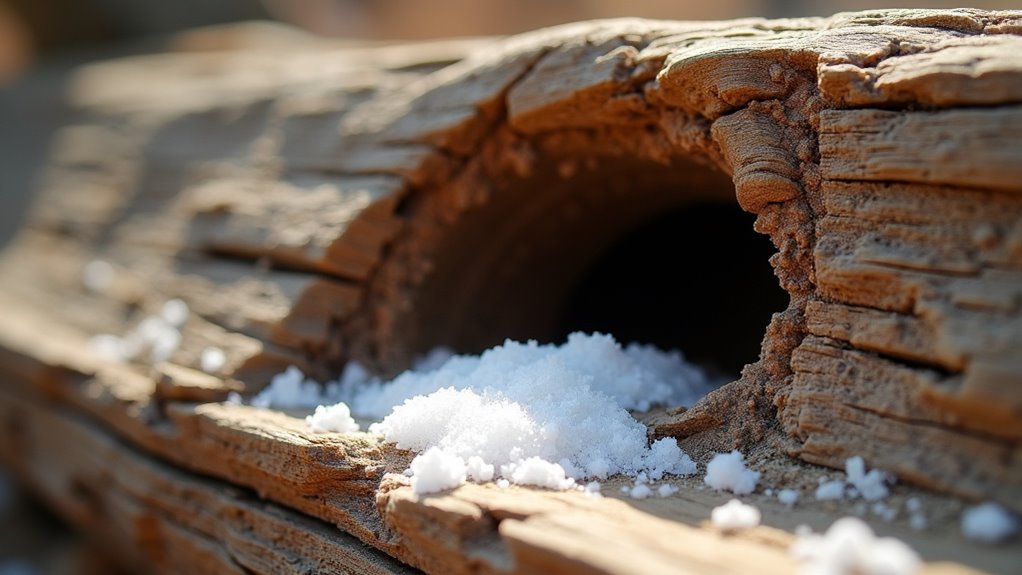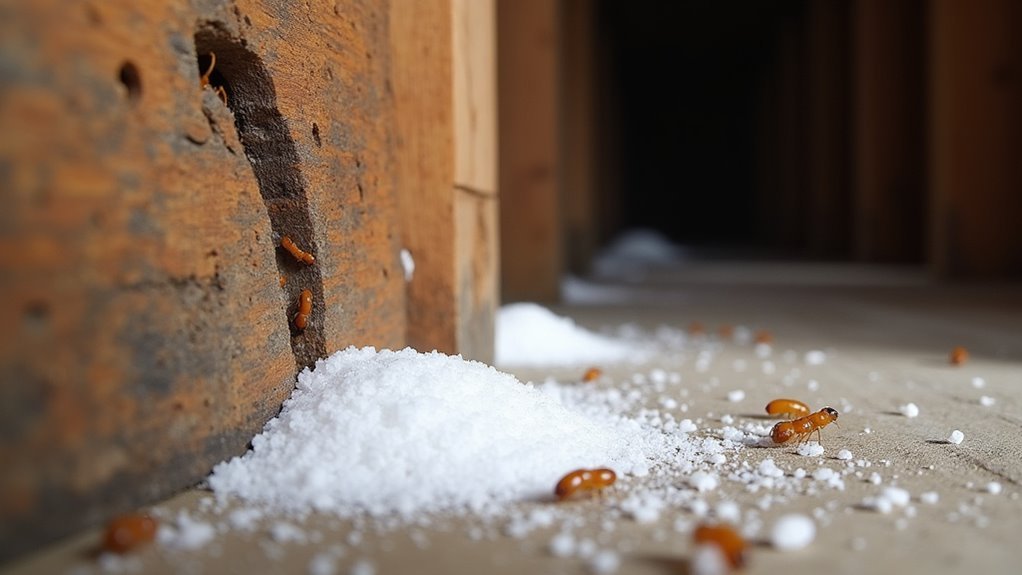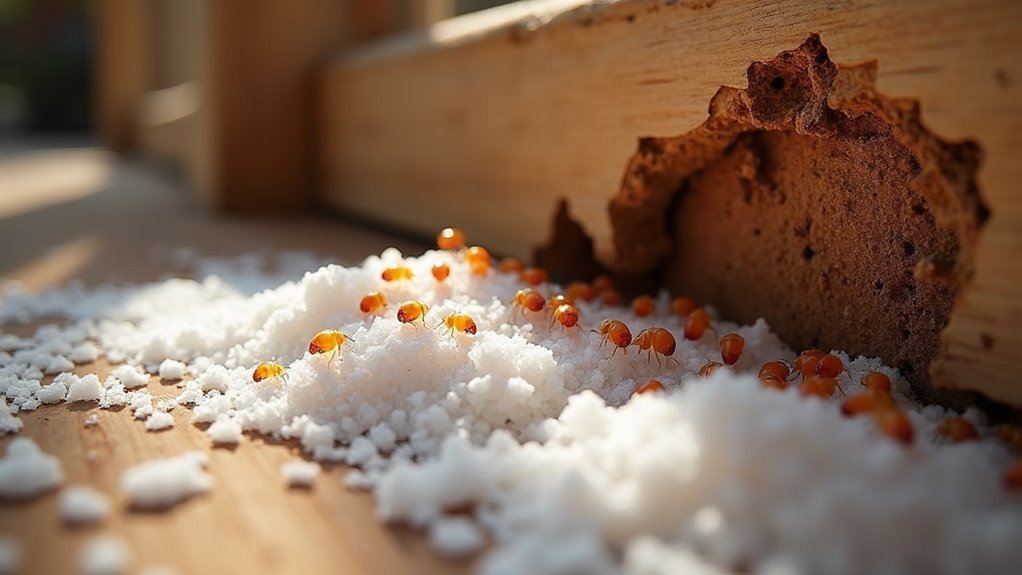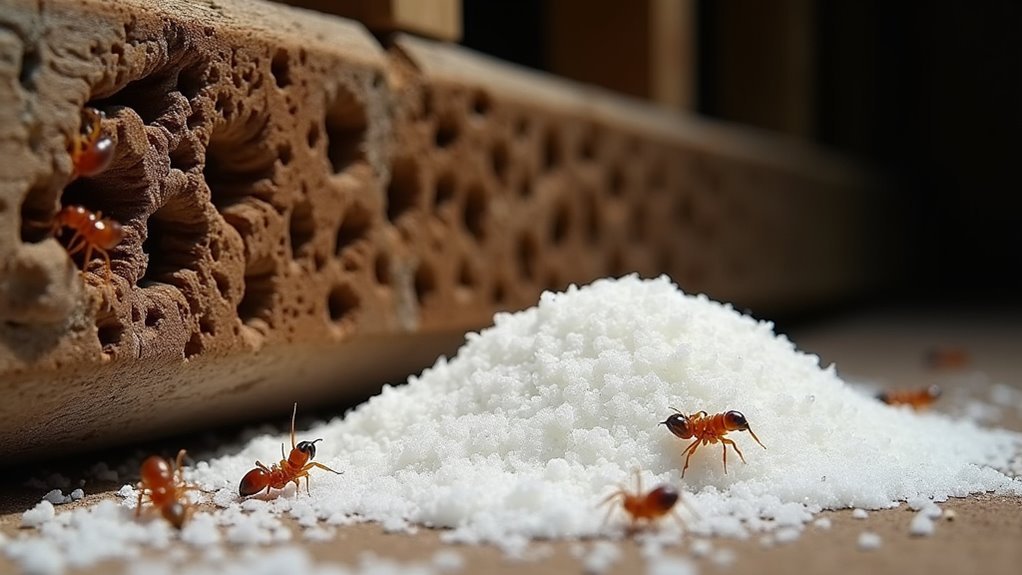Salt fails as termite control because it only kills termites on contact at the surface level, while colonies build extensive tunnel networks deep within wood where salt can’t reach. You’ll find that salt doesn’t penetrate moisture-rich wood effectively, leaving the queen and core colony members protected and continuing reproduction. Even when surface workers die, they’re quickly replaced, and termites actively avoid salt-treated areas, making this DIY method ineffective for eliminating entire infestations and preventing the structural damage that costs homeowners thousands in repairs.
Salt’s Limited Penetration Into Wood Structures

Although salt can kill termites on contact, it won’t penetrate deep into wood structures where these destructive insects typically establish their colonies. When you spray salt solutions onto infested wood, you’re only treating the surface layer.
Salt kills termites on contact but fails to penetrate wood structures where colonies actually establish themselves.
The salt simply can’t reach the extensive tunnel networks and nests that termites build within the wood’s interior.
Your termite problem persists because these pests create complex systems of galleries hidden from view. Even if you manage to kill some exposed termites, the majority remain safely tucked away in untreated areas.
The wood’s moisture content further prevents salt absorption, creating barriers that protect the colony. You’ll find that salt’s surface-level action makes it ineffective against the core infestation lurking deep within your wooden structures.
Why Termite Colonies Survive Salt Applications
When you apply salt to combat termites, you’re only targeting the workers and soldiers near the surface while the colony’s queen remains safely hidden deep within the nest or underground tunnels.
The complex structure of termite colonies creates multiple layers of protection that prevent salt from penetrating to the core reproductive members who actually sustain the population.
You’ll find that even if salt kills some visible termites, the protected queens continue laying thousands of eggs daily, ensuring the colony’s survival and regrowth.
Colony Structure Protects Members
Since termite colonies consist of thousands of individuals spread across vast underground networks and wooden structures, salt applications can’t reach every member of the population. You’re dealing with a sophisticated social structure where workers shield reproductive members deep within the colony’s core.
| Colony Level | Protection Factor | Salt Accessibility |
|---|---|---|
| Surface Workers | Minimal protection | Partially vulnerable |
| Mid-level Tunnels | Moderate protection | Limited access |
| Queen’s Chamber | Maximum protection | No access |
Salt only affects exposed workers on the surface while the queen and reproductive termites remain safely buried underground. Their protective exoskeletons further reduce salt’s dehydrating effects. When you apply salt to visible areas, you’re targeting less than 10% of the actual colony. For effective treatment of termite infestations, professional pest control methods penetrate deeper colony structures.
Salt Cannot Reach Queens
While salt may eliminate worker termites foraging near the surface, it can’t penetrate the protective depths where queen termites establish their breeding chambers. This fundamental limitation makes salt ineffective as a thorough pest control solution.
Queens remain safely nestled in underground colonies where salt applications can’t reach them.
Consider why this creates ongoing problems:
- Queens produce thousands of eggs annually, ensuring continuous colony growth
- Breeding chambers are located deep underground, far from surface salt treatments
- Worker termites you kill represent only a tiny fraction of the total population
- New workers quickly replace eliminated ones, maintaining colony operations
- Underground tunnel networks remain completely unaffected by surface applications
Without targeting the queen, any termite treatment becomes pointless since she’ll continue reproducing indefinitely.
Structural Damage Risks From Salt Treatments

Although salt might seem like a harmless household remedy for termite problems, it can actually create serious structural damage that outweighs any potential benefits.
Salt treatments corrode and deteriorate concrete structures, creating weaknesses in your foundation over time. When you apply salt improperly, uneven distribution creates localized high salinity zones that compromise building materials and structural integrity.
Salt’s corrosive properties weaken concrete foundations and create dangerous structural vulnerabilities through uneven chemical distribution.
High salt concentrations also damage vegetation around your foundation, destabilizing soil and landscaping that support your home’s structure.
Most concerning, salt’s ineffectiveness against subterranean termite colonies means structural damage from these pests continues unchecked while you rely on failed control methods.
You’re fundamentally creating new structural problems while existing termite damage progresses unaddressed, putting your home’s safety at serious risk.
The Science Behind Salt’s Dehydration Claims
When salt comes into contact with termites, sodium chloride disrupts their internal water balance by drawing moisture from their bodies through osmosis.
However, this dehydration mechanism has significant limitations that make it unreliable for effective pest control.
The science reveals several critical flaws in salt’s effectiveness:
- Termites actively avoid salt-treated areas, preventing direct contact needed for dehydration
- Individual termite deaths don’t impact colony survival since workers are easily replaceable
- Salt requires sustained direct contact, which rarely occurs in real-world conditions
- Termites possess natural moisture-seeking behaviors that help them circumvent treated zones
- The dehydration process affects only exposed termites, leaving protected colony members unharmed
These scientific realities explain why salt consistently fails as a thorough termite control solution despite its theoretical dehydrating properties.
Professional Vs DIY Treatment Effectiveness

When you’re weighing salt against professional termite treatments, you’ll quickly notice stark differences in treatment scale limitations that make DIY approaches inadequate for serious infestations.
Your application methods with salt can’t match the precision and coverage that licensed professionals achieve with specialized equipment and techniques.
The long-term success rates between these approaches reveal why most homeowners who initially try salt eventually need to call in the experts anyway.
Treatment Scale Limitations
While salt might kill individual termites you encounter, it’s virtually useless against the massive colonies that threaten your home’s structure.
You’re dealing with thousands of termites hidden deep within your walls, not just the few you can see.
The scale limitations of salt treatment become obvious when you consider:
- Termite colonies contain thousands of members spread throughout your property
- Salt can’t penetrate deep into wooden structures where colonies establish
- You can’t access hidden nest locations without professional equipment
- Surface treatments miss the reproductive queens essential for colony elimination
- DIY methods lack the systematic approach needed for complete eradication
Professional pest control addresses these scale challenges through extensive treatments that reach entire colonies, while your salt shaker simply can’t match that level of thoroughness.
Application Method Gaps
Beyond the scale problem, the way you apply salt creates another major gap between DIY attempts and professional effectiveness.
When you sprinkle table salt around your property, you’re fundamentally hoping termites will walk through it. However, salt must make direct contact with individual termites to work, which rarely happens with surface applications.
Professional termite specialists use specialized equipment and targeted techniques that guarantee active ingredient reaches actual termite colonies. They understand termite biology and behavior patterns, allowing them to place treatments where termites actually live and travel.
Your DIY salt method lacks this precision and knowledge. Additionally, professionals minimize structural damage while maximizing termite exposure.
When you apply salt incorrectly, you risk damaging concrete and other materials without effectively reaching the pest population.
Long-Term Success Rates
Although salt might kill a few termites on contact, the stark difference in long-term success rates reveals why this DIY approach consistently fails homeowners.
Professional treatments deliver over 90% effectiveness in eliminating entire infestations, while salt-based methods typically fail within months.
When you’re facing a serious pest problem, consider these success rate comparisons:
- Professional treatments eliminate colonies completely, including the queen
- Salt only kills surface termites, leaving colonies intact underground
- DIY methods result in high re-infestation rates within 6-12 months
- Expert fumigation provides multi-year protection with warranties
- Combination treatments using advanced pesticides aren’t available to homeowners
You’ll spend $3,000 on professional treatment versus potentially $5 billion in structural damage from failed DIY attempts.
The long-term success rates clearly favor professional intervention over temporary salt solutions.
Better Natural Alternatives to Salt for Termites
When standard table salt falls short in termite control, you’ll find several natural alternatives that deliver superior results.
Borate salts, particularly sodium borate, excel where regular salt fails by disrupting termites’ nutrient absorption, causing starvation rather than simple dehydration. You can apply these treatments around infested areas with confidence in their effectiveness.
Nematodes offer another powerful biological solution. These microscopic roundworms actively hunt and consume termites while remaining completely safe for your family, pets, and plants.
Unlike salt’s hit-or-miss approach, nematodes provide targeted pest control that won’t harm beneficial insects.
Professional heat treatments represent the most thorough alternative, using lethal temperatures to eliminate entire colonies.
Eco-conscious pest control companies increasingly recommend borate-based solutions for sustainable, long-term termite prevention that actually works.
Frequently Asked Questions
Does Salt Really Kill Termites?
Salt may kill a few individual termites through dehydration, but you won’t eliminate entire colonies. You’re facing resilient pests with large populations living in protected environments where salt can’t reach them effectively.
What Is the Most Effective Chemical for Termite Control?
You’ll find fipronil and imidacloprid are the most effective termiticides, disrupting termites’ nervous systems. These liquid treatments create long-lasting soil barriers around your home, while borate treatments provide excellent wood protection against future infestations.
What Is the Most Effective Termite Control Method?
You’ll get best results with professional extermination using tailored treatments like fumigation, localized applications, or baiting systems. Combine this with regular inspections and preventive measures like foundation clearance and protective wood treatments.
What Do Termites Hate Most?
Termites hate sunlight most since it’ll kill them with prolonged exposure. They also despise borate, which starves them, plus vibrations, strong essential oil scents, and dry conditions that cause dehydration and force them away.
In Summary
You’ve seen how salt fails to penetrate wood structures effectively, can’t eliminate entire termite colonies, and poses serious risks to your home’s structural integrity. The dehydration claims don’t hold up scientifically, and DIY salt treatments can’t compete with professional solutions. Instead of wasting time and potentially damaging your property, you’ll get better results with proven natural alternatives like diatomaceous earth or boric acid treatments.





Leave a Reply